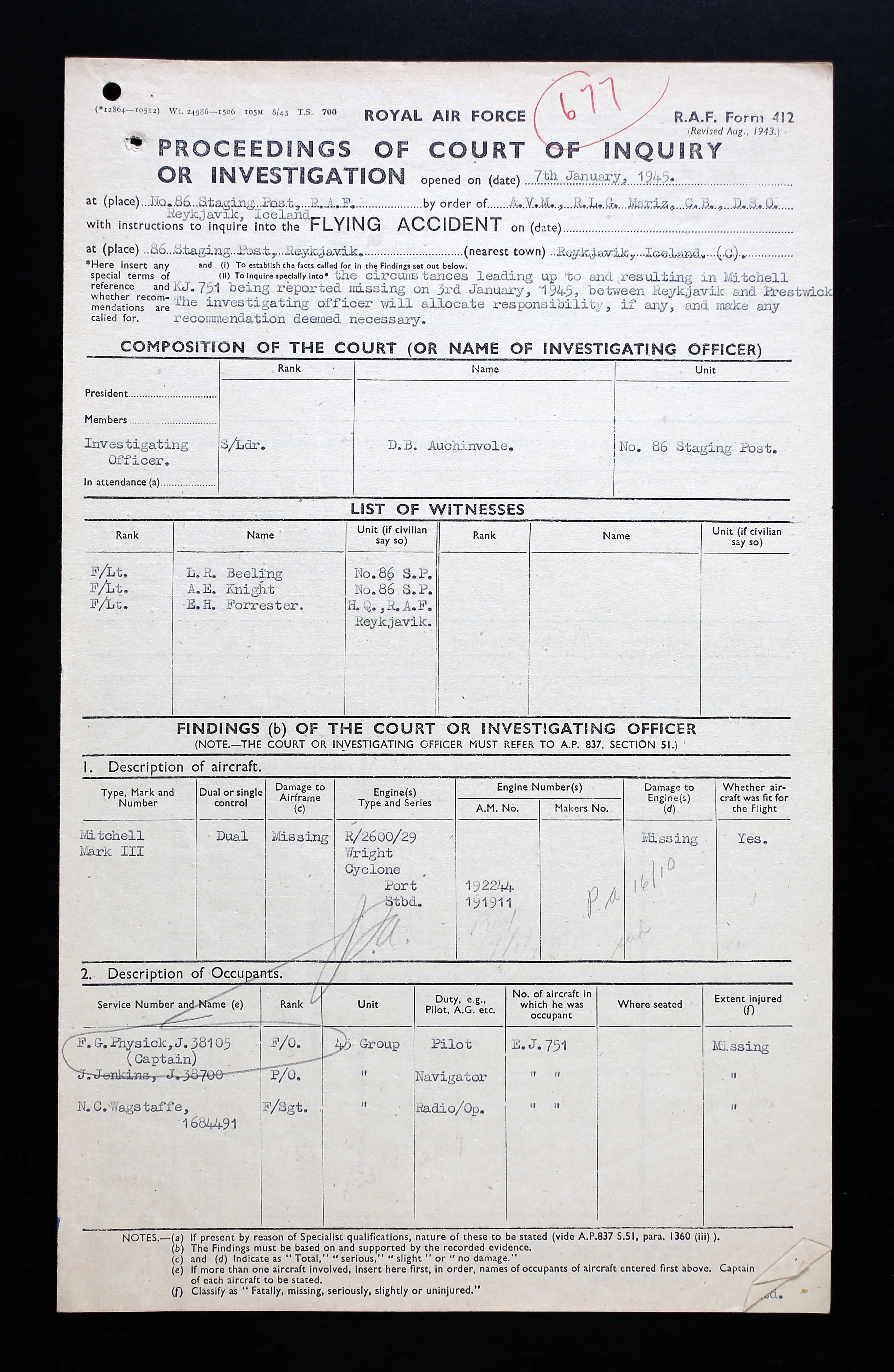
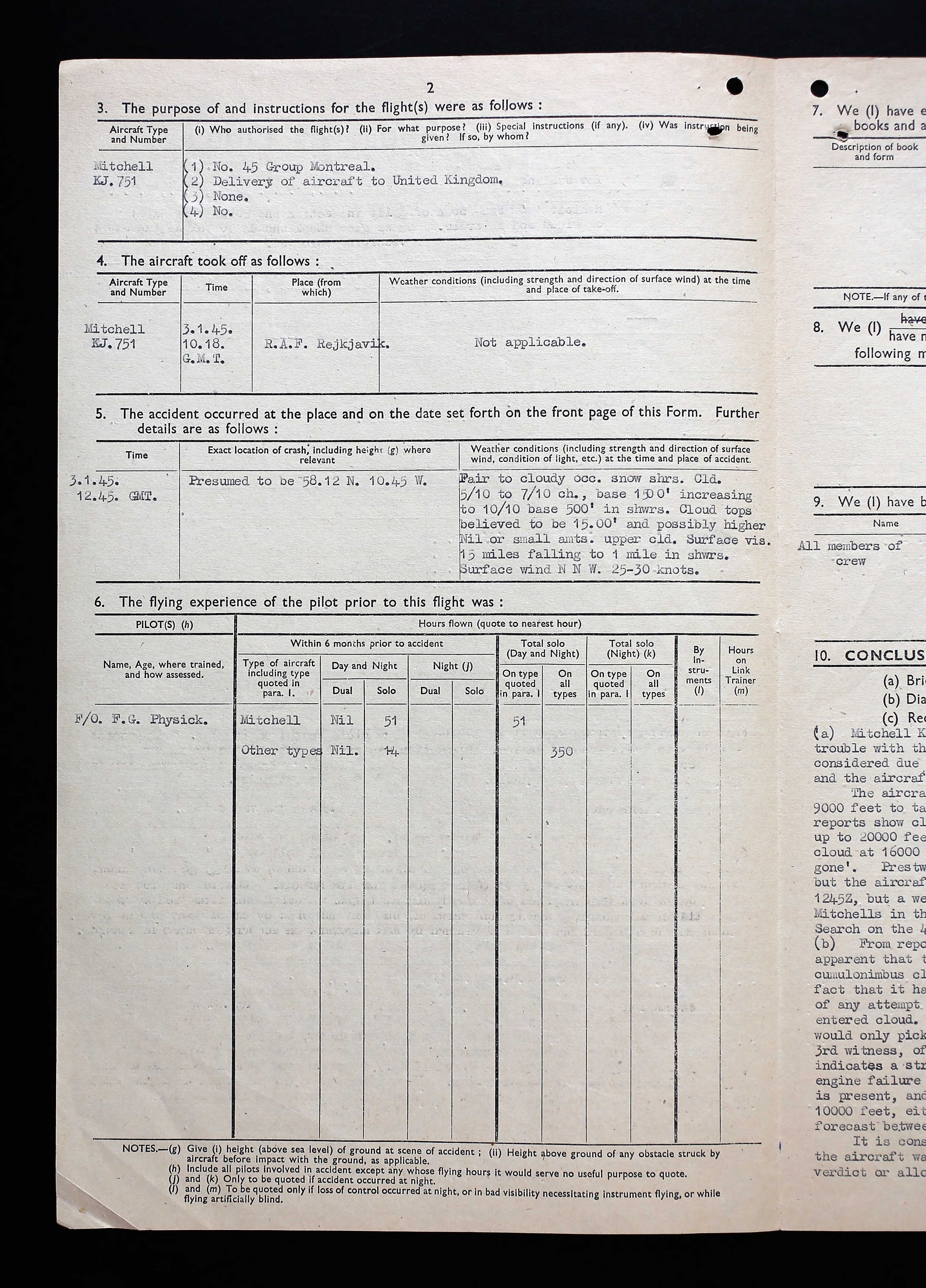
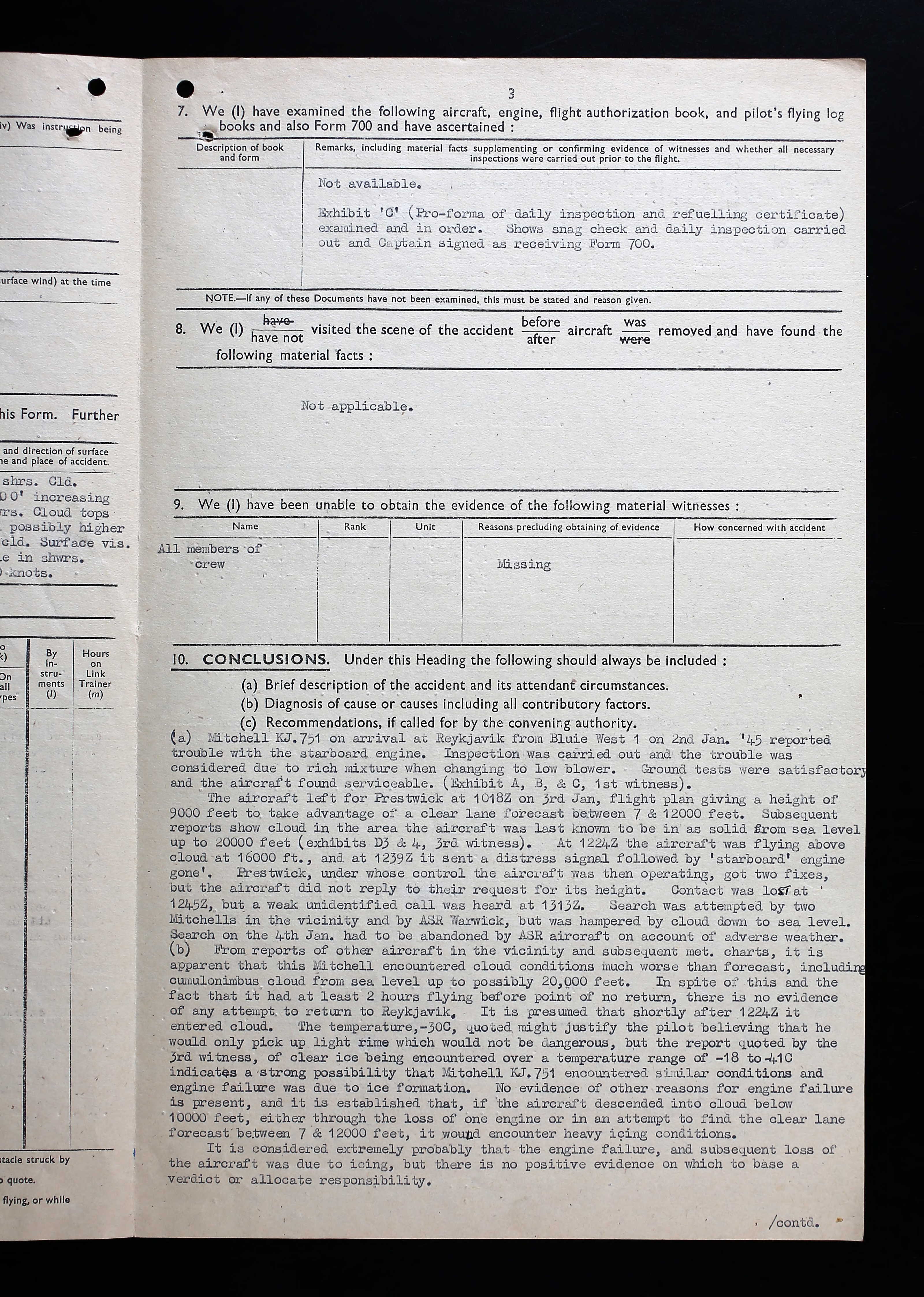
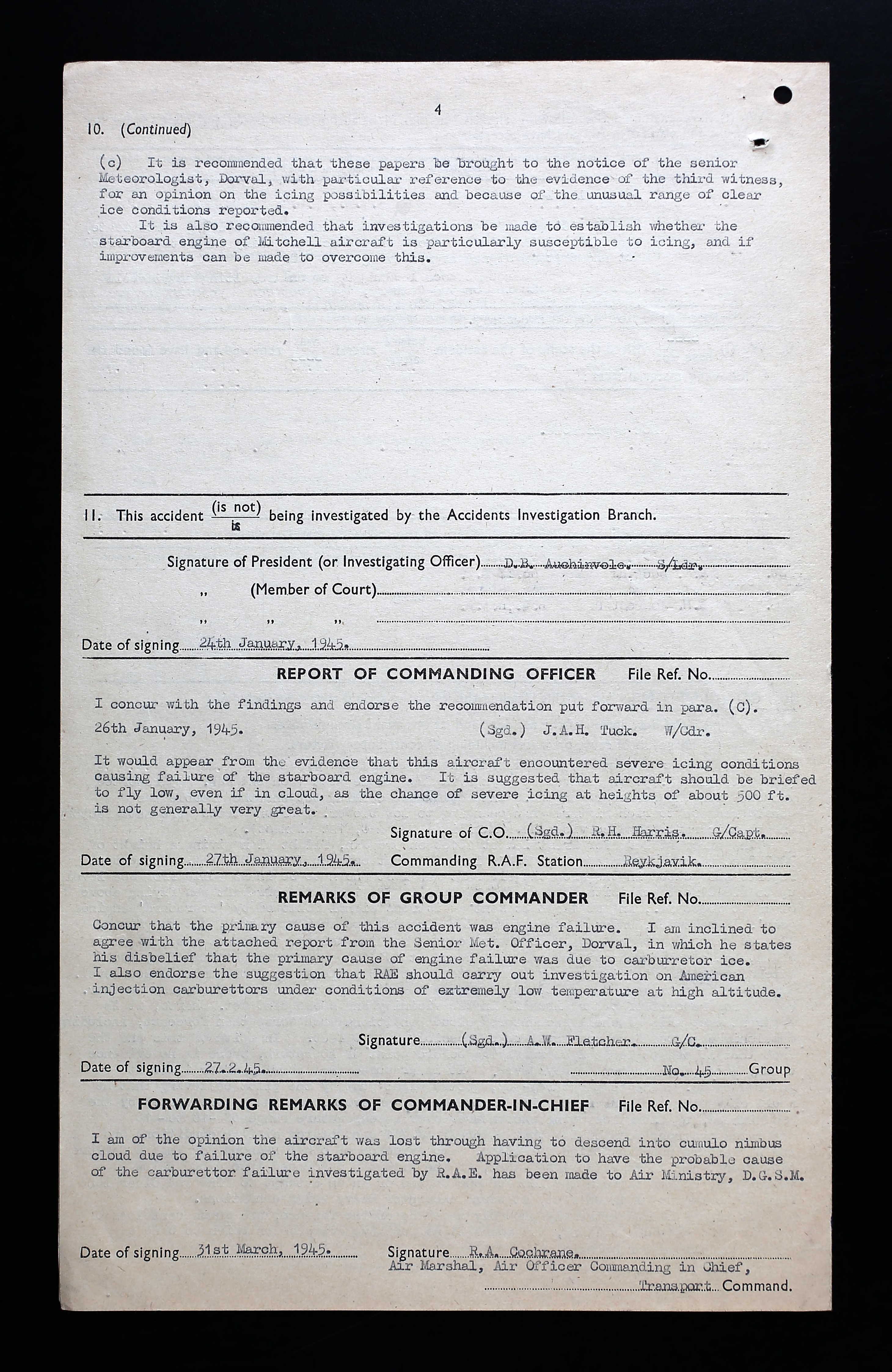

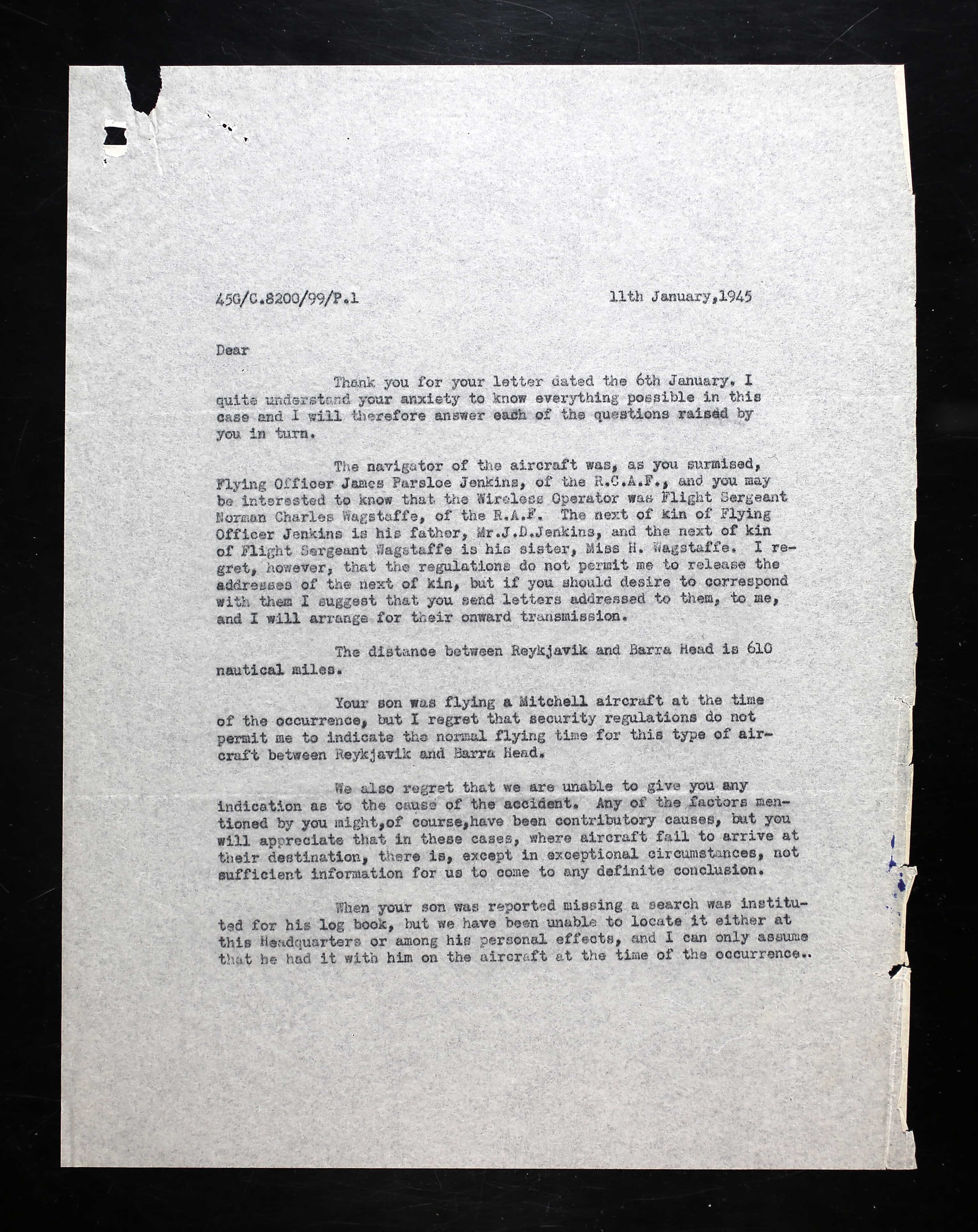
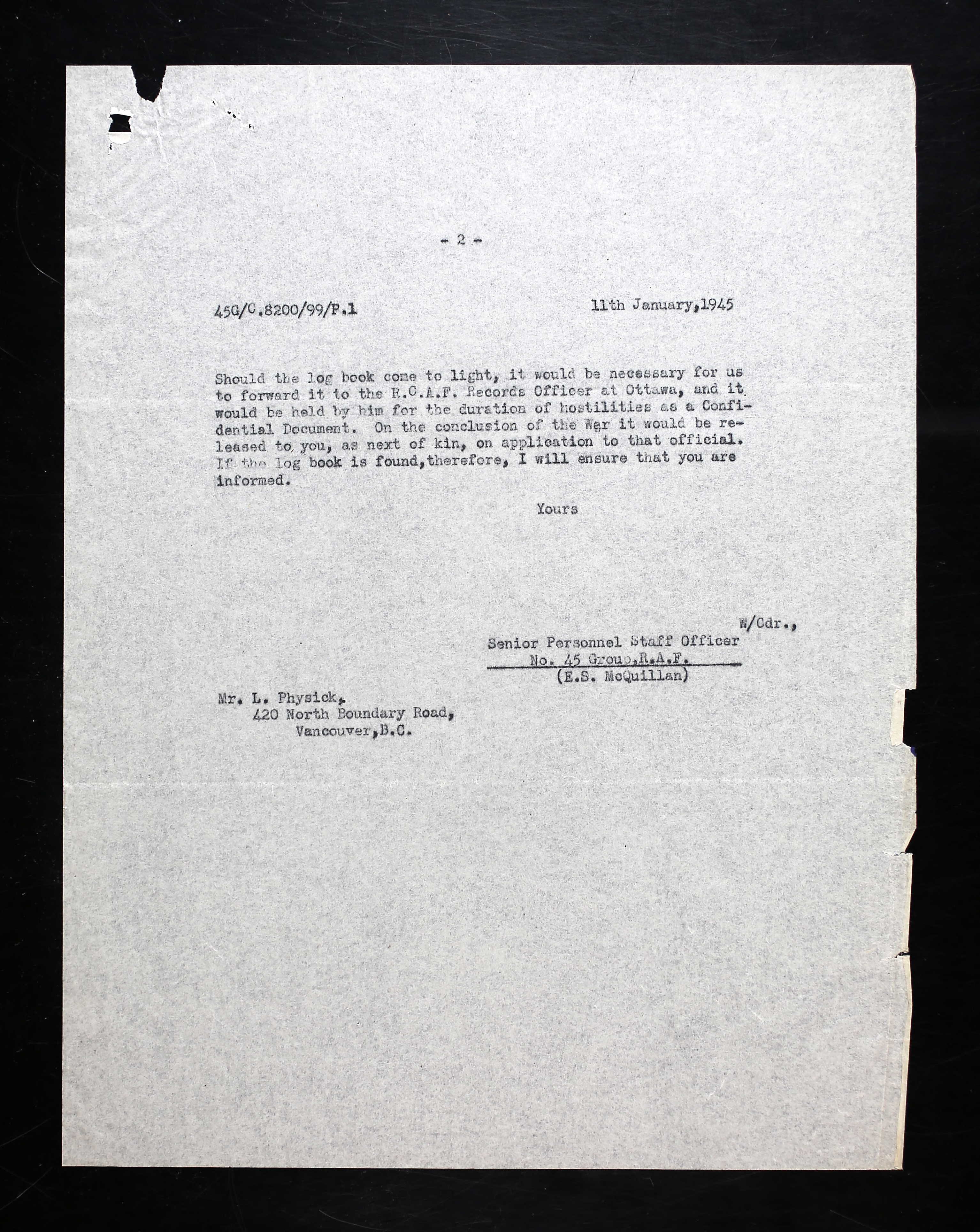
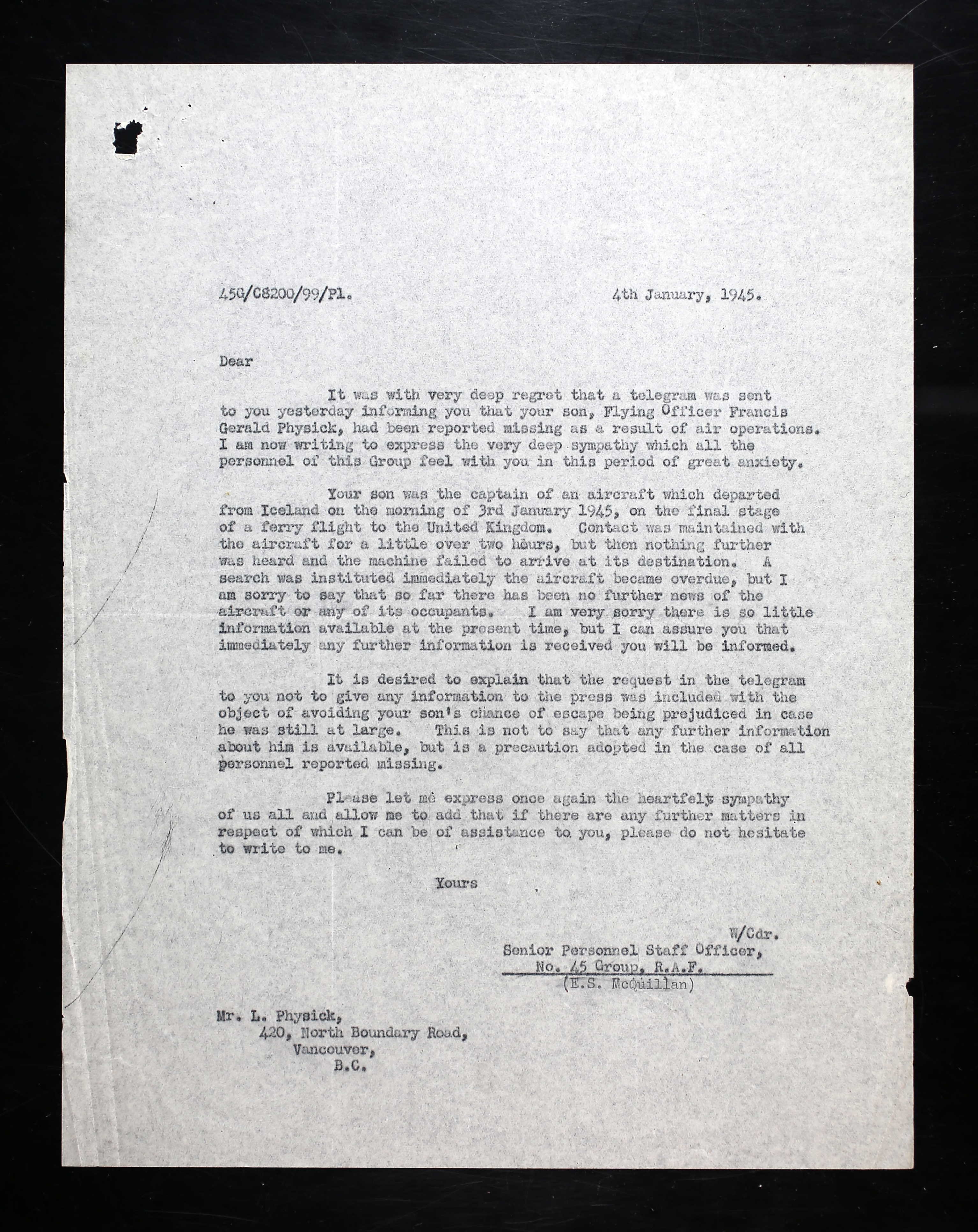

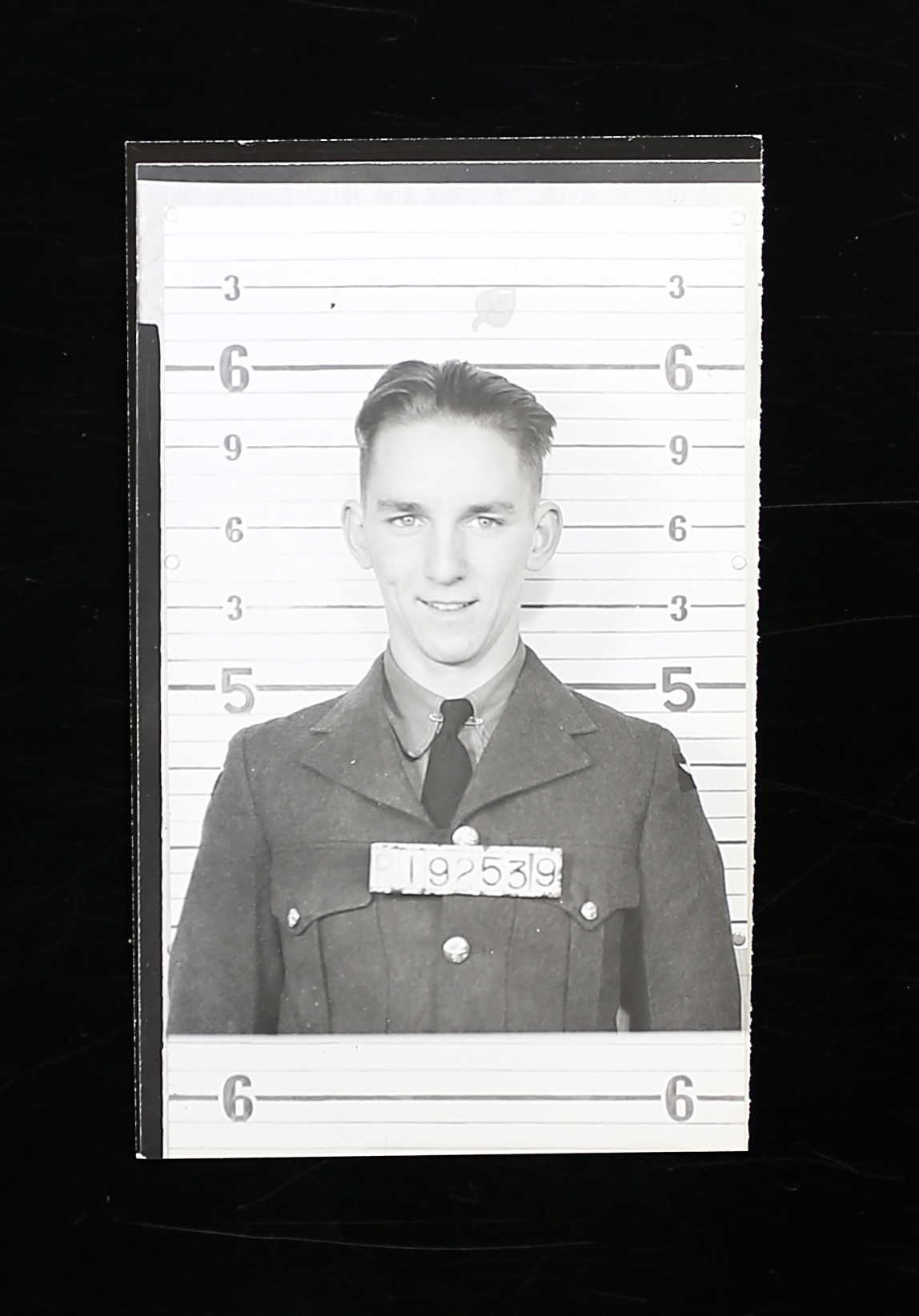
April 24, 1924 - January 3, 1945










Francis Gerald Physick, known as Frank, was the only son of Lewis Baker Physick (1905-1970), superintendent for Consolidated Truck Lines, and Magdalene Cecelia (nee Pillatt) Physick (d. 1928) of Vancouver, British Columbia. Francis’s stepmother, who married Mr. Physick on March 24, 1934, was Millicent (nee Edwards, formerly Taylor) Physick (1894-1971). He had one stepsister, Doreen. The family was Anglican.
Frank was a student when he enlisted with the RCAF. He had worked at the North Burrard Shipyards as a heater, from July to September 1942. He liked to collect stamps, enjoyed swimming, rugby, soccer, baseball, and basketball. He had one year of Air Cadets. He stood 5’ 9 ½” tall and weighed 140 pounds. Two scars on his knees were noted. “Wiry, alert. Keen, young, physically fit, eye muscle balance poor; neglect in left eye, good observer or WAG.” Other comments: “Physical: fit. Mental. Average education. Is alert and intelligent. Work history fairly good. Took WETP to stay with friend. Motivation: Boyhood ambition to fly. Wants ops. Temperament: Young. Very keen and enthusiastic. Is mature. Has colour, initiative, self-confidence and aggressiveness. Home relations poor. Had to buy own clothes and work at home since stepmother was working. Had intended to put self through medicine. Stability and stamina good. May be inclined to be erratic at times from over enthusiasm.”
Frank was at No. 3 Manning Depot, Edmonton, Alberta, September 21 until November 15, 1942. Between November 16, 1942 and February 5, 1943, he was at Regina. While there at No. 2 ITS, Frank took the Pre-Aircrew Education Course and scored 84% in English, 63% in Science and 100% in Mathematics. “Good ability, accuracy needs to be improved.” Frank was 38th out of 103, with 79.2%. “This airman’s attitude and application have been good throughout the course. The results of this work have been above average. He is good-natured and jovial and seems to possess the drive and initiative necessary to carry his training through to a successful conclusion. Alternative: Bomber.” He was at the station hospital from March 10 – 14, 1943.
He was sent to Winnipeg, Manitoba, February 6 – March 6, 1943, No. 3 Wireless School.
At No. 15 EFTS, Regina, Saskatchewan from May 16 – July 24, 1943, he was 14th out of 24 with 70.1%. “Good discipline. Always on the job. Can depend upon him. High average pilot. Airmanship, air sense, and co-ordination good. Aerobatics average. High average instrument pilot. Smooth and relaxed. Quick to make corrections.”
At No. 3 SFTS, Calgary, Alberta July 25 to November 12, 1943, he earned 75.5% in ground training and 71.6% in flying tests. “High average pilot.” Frank was seen as ‘definitely suitable’ for bomber and fighter type aircraft.
At No. 34 O.T.U., Pennfield Ridge, NB, November 27, 1943, to March 11, 1944: “This pilot is keen and steady in an emergency. He could have done better on his course particularly in ground subjects with greater application. His flying is a good average.” Ground Instructor: “Average although above average in bombing and gunnery.” General Assessment: “This pupil’s marks in all theoretical work were consistently low all through the course, was definitely not interested in the least in theoretical work and underestimated the values to be gained through classroom instruction. Is capable of doing better with a little more application. Practical bombing, however, was above average and he showed good crew cooperation.”
On March 12, 1944, Frank reported to Dorval, Quebec and was posted to 45 (AT) Group, RAF. He went missing aboard Mitchell KJ751 January 3, 1945. Crew: NAVIGATOR Flying Officer James Parsloe Jenkins, J38700, PILOT Flying Officer Gerald Physick, J38105, and RADIO OPERATOR Flight Sergeant Norman Charles Wagstaffe, 1684491 RAF. The plane ditched on during a ferry flight between Reykjavik, Iceland and Prestwick, Scotland. His BC death certificate reads, “Place of Death: Overseas en route Iceland to United Kingdom.”
Proceedings of Court of Inquiry or Investigation dated January 7, 1945, at No. 86 Staging Post, RAF Reykjavik, Iceland to determine “the circumstances leading up to and resulting in the Mitchell Kj751 being reported missing January 3, 1945, between Reykjavik and Prestwick. The investigating officer will allocate responsibility, if any, and make a recommendation deemed necessary.” Three witnesses were called. The weather was fair to cloudy, with occasional snow. Surface visibility 15 miles falling to one mile in showers. Surface wind NNW 25-30 knots. “On January 2, 1945, the airport reported trouble with the starboard engine. Inspection was carried out and the trouble was considered to be ‘too rich mixture when changing to low blower.’ Ground tests were satisfactory, and the aircraft was found serviceable. The aircraft left for Prestwick at 1018Z on January 3rd, flight plan giving the height of 9000 feet to take advantage of a clear lane forecast between 7 and 12,000 feet. “Subsequent reports show cloud in the area the aircraft was last known to be in as solid from sea level up to 20,000 feet. At 1224Z, the aircraft was flying above cloud at 16,000 feet, and at 1239Z, it sent a distress signal followed by ‘starboard engine gone.’ Prestwick, under whose control the aircraft was then operating, got two fixes, but the aircraft did not reply to their request for its height. Contact was lost at 1245Z, but a week unidentified call was heard at 1313Z. search was attempted by two Mitchells in the vicinity and by ASR Warwick, but was hampered by cloud down to sea level. Search on January 4th had to be abandoned by ASR aircraft on account of adverse weather… there is no evidence of any attempt to return to Reykjavik… temperature, -30C, quoted might justify the pilot believing that he would only pick up light rime which would not be dangerous, but the report quoted by the third witness of clear ice being encountered over a temperature range of -18C to -41C indicates a strong possibility that Mitchell KJ751 encountered similar conditions and engine failure was due to ice formation. No evidence of other reasons for engine failure is present, and it is established that, if the aircraft descended into cloud below 10,000 feet, either through the loss of one engine or in an attempt to find the clear lane forecast between 7 and 12,000 feet, it would encounter heavy icing conditions. It is considered extremely probable that the engine failure, and subsequent loss of the aircraft was due to icing, but there is no positive evidence on which to base a verdict or allocate responsibility.” The conclusion was made that the primary cause of this accident was engine failure, possibly carburetor failure.
Mr. Physick received a letter dated January 4, 1945, outlining the circumstances of Frank being reported missing. “Your son was the captain of an aircraft which departed from Iceland on the morning of 3rd January 1945, on the final stage of a ferry flight to the United Kingdom. Contact was maintained with the aircraft for a little over two hours, but then nothing further was heard and the machine failed to arrive at its destination. A search was instituted immediately the aircraft became overdue, but I am sorry to say that so far there has been no further news of the aircraft or any of its occupants…”
A letter written by Mr. Physick, dated January 6, 1945: “I received your letter referring to the report that my son was missing… I wish to thank you for your comforting letter. The two boys [was this James Parsloe Jenkins?] were very close to me and during their last leave, we had several chats together which makes me feel as if I, myself, have flown from Dorval to Prestwick in a B25 with them! I would appreciate, if possible, you answering a few questions for me. The information is only to satisfy in my own mind questions for which I have asked myself and could not discuss with anybody not familiar with the route or conditions. If you cannot answer because of military secrets or because you are exceeding your authority, I will understand and not feel prejudice towards you or anyone. But as I know there is little, if any, hope for the boys, I would like full particulars. I am listing the questions individually to enable you to judge the feasibility of answering them. 1. If Flying Officer Jenkins was navigator on the same ship or names of the crew? 2. Distance between Reykjavik and Barra Head? 3. Type of aircraft he was piloting and its normal flying time between Reykjavik and Barra Head? 4. Was engine failure, ice or off their course cause of the mishap? 5. The possibility of having his logbook filled in on the last trip by an officer familiar with the route up to the time of disaster and sent to me. I can guess the answers to most of these questions but would feel a lot better having official detail given to me. Thanking you in advance and once again repeating that if for any reason you were unable to answer my requests, all or any, I will not feel prejudiced. Sincerely and best of luck to 45 (AT) Group.”
On January 11, 1945, W/C E. S. McQuillan, Senior Personnel Staff Officer replied to Mr. Physick. “Thank you for your letter dated the 6th of January. I quite understand your anxiety to know everything possible in this case and I will therefore answer each of the questions raised by you in turn. The navigator of the aircraft was, as you surmised, F/O James Parsloe Jenkins, of the RCAF, and you may be interested to know that the wireless operator was F/S Norman Charles Wagstaffe of the RAF... I regret however that the regulations do not permit me to release the addresses of the next of kin, but if you should desire to correspond with them, I suggest that you send letters addressed to them to me, and I will arrange for their onward transmission. The distance between Reykjavik and Barra Head Is 610 nautical miles. Your son was flying a Mitchell aircraft at the time of the occurrence, but I regret that security regulations do not permit me to indicate the normal flying time for this type of aircraft between Reykjavík and Barra Head. We also regret that we are unable to give you any indication as to the cause of the accident. Any of the factors mentioned by you might, of course, have been contributory causes, but you will appreciate that in these cases, where aircraft failed to arrive at their destination, there is, except in exceptional circumstances, not sufficient information for us to come to any definite conclusion. When your son was reported missing, a search was instituted for his logbook, but we have been unable to locate it either at this headquarters or among his personal effects, and I can only assume that he had it with him on the aircraft at the time of the occurrence. Should the logbook come to light, it would be necessary for us to forward it to the RCAF Records Officer at Ottawa, and it would be held by him for the duration of hostilities as a confidential document. On the conclusion of the war, it would be released to you, as next of kin, an application to that official. If the logbook is found, therefore, I will ensure that you are informed.”
In a letter addressed to Mr. Physick, dated January 26, 1945: “…I have been informed by Mr. Currie…Montreal, that your son had left in the open at his establishment a Model A 1931 Ford automobile. Mr. Currie mentioned that it was in such a condition as to more of a liability than an asset and it is improbable that it could be moved under its own power. Mr. Currie has also stated that he has received an offer of $50 in cash for the car. I duly informed the Director of Estates of the position with regard to the car, and he suggests that I obtain your instructions as to the disposal thereof, in view of the fact the machine, being in civil custody, does not come within the jurisdiction of the RCAF.”
In a letter dated April 18, 1946, Mrs. Physick wrote, “For certain sentimental reasons, my husband declined to write any letters in connection with the matter and in accordance, I have completed same myself as the mother of the deceased in the presence of a notary public. Your records will show I answered the last letter concerning the same at my husband’s request, so please address to me any further communications in the matter.” In a letter dated September 14, 1946, written by Frank’s stepmother, “Please find enclosed two receipt forms for my son’s belongings. In reference to gratuity funds, would you please send me information regarding the distribution of same. I presume my husband and I are entitled to the allowance. I would be very pleased if you would write and advise me as to the procedure. PS. Sorry these forms have not been sent in sooner, but my husband refuses to do any writing in connection with the matter as I have explained before.”
In late October 1955, Mr. Physick received a letter informing him that since his son had no known grave, his name would appear on the Ottawa Memorial.